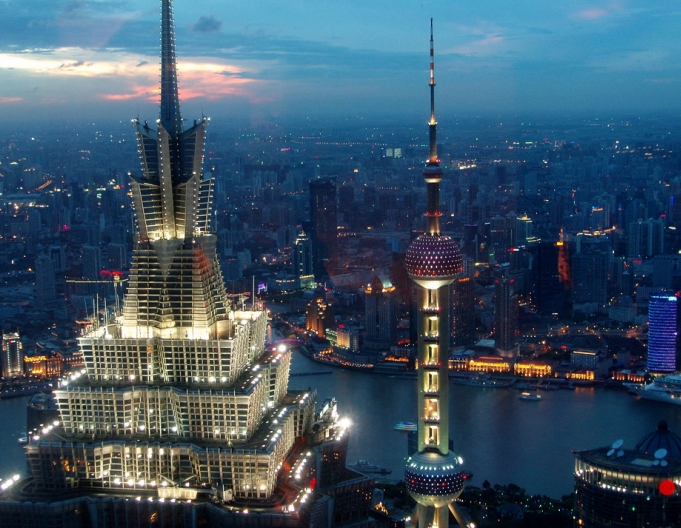Skyscraping Triumvirate
SHANGHAI – Shanghai Tower will eventually be a sight to behold. But right now it’s nothing more than an ugly concrete cube – 15 floors’ worth, surrounded by steel girders. Hundreds of workers mill about the construction site, which is tucked in amid freeways. Passersby – women clad in pretty ensembles and elegantly dressed businessmen – don’t even glance at the imposing sight. Residents of China’s economic capital are used to seeing buildings crop up like mushrooms in a rainy autumn forest.
And yet this skyscraper marks the apotheosis of a daring project launched by Chinese authorities nearly two decades ago. It was 1993 when plans were unveiled to build three giant towers that would symbolize past, present and future. The first of the three behemoths was christened Jim Mao Tower, the second the Shanghai World Financial Center, and the third Shanghai Tower. All three were to be built on a piece of land that otherwise was home to run-down buildings and rice fields.
In the early 1990s, Pudong, as this particular area is called, didn’t look very promising. While neighborhoods on the other side of the Huangpu River were developing quickly, this space interested no one. Central authorities decided to transform the zone into nothing less than a gigantic business quarter that could vie with Hong Kong or Singapore. And as is often the case in China, there was no pussy-footing around when authorities decided to move ahead with the project.
To attract promoters, the city financed construction of a 486-meter (1,535.5-foot) TV tower. The Oriental Pearl Tower resembles a giant display building comprised of three spheres of differing sizes linked by thick tubes of roughly-finished concrete. At night, it becomes a piece of illuminated kitsch– like the boats plying the river – in strident colors: candy pink, neon green, electric blue. Charming? The Chinese seem to like it. Every year, the tower – a symbol of Shanghai’s renewal – is visited by 3 million people.
A skyscraping triumvirate
But the tower was just a first step. Hoping to impress lovers of beautiful architecture – which the Oriental Pearl Tower is not – the City of Shanghai decided to call on the best architectural firms to build the first of the three skyscrapers that would incarnate the rebirth of a great city. The result, Jim Mao Tower, is a genuine success. Designed according to the principles of Feng Shui, the 88-story tower (8 = prosperity) was the highest building in China when it was inaugurated in 1998.
Ten years later, the Shanghai World Financial Tower – at 492 meters (1,614 feet) – robbed it of that honor. Nicknamed “the bottle opener” because of its shape, the billion-dollar tower was originally supposed to feature a round aperture at the summit. But Shanghai residents felt that the design was too reminiscent of the Japanese flag, so the (Japanese) construction company in charge of the project had to change the design.
After 9/11, engineers also had to tweak the concept to accommodate empty floors on seven levels where people could gather in the event of fire or other catastrophe. On the 90th floor, at an extra cost of $200 million, two huge counterweights weighing 150 tons each were installed so that the tower wouldn’t move too much during stormy weather.
Shanghai Tower will be even more “technological.” Designed by the American firm Gensler, its concept comprises nine central tubular structures posed one on top of the other, enveloped by a spiral glass casing that is supposed to act like a thermos, preserving the evening cool during the summer months and afternoon warmth during the winter. Huge green spaces, a rainwater recovery system and wind turbines on the roof should mean considerable energy savings for the 632-meter (2,073-foot), 124-story building. An ecological future… even in China.
Slowing sinking in
Shanghai’s high rise building boom has also had some misses. Another tower, Tomorrow Square in the Puxi district, is indescribably ugly. In some cases, the developments have also been preceded by wide scale demolition – colonial neighborhoods have been razed to make room for unattractive apartment buildings and freeways.
In the heart of the city, nine lanes crisscross each other around a central pillar representing nine dragons. And the city’s rapid expansion shows no signs of slowing down. “There are 12,000 buildings in Shanghai – two new ones are inaugurated every single day,” says Tan Ronghua, a local guide.
“The first bridge crossing the river to Pudong was inaugurated in 1994. Today, there are six bridges and 27 tunnels. But you need that because 20% of the city’s 18.5 million inhabitants now live here and they need to be able to get around,” he adds.
This construction fever also harbors dangers. Built in a water-gorged seismic zone, the city is sinking at the rate of one centimeter per year. In his book Empire of the Sun, James Graham Ballard evoked the decadence of Shanghai in the 1930s, a city described as living only in an intense present with no thought of tomorrow. Along the banks of the Huangpu, that’s probably about the only thing that hasn’t changed in the last eight decades.

That is really attention-grabbing, You are a very professional blogger. I have joined your feed and look ahead . Prince Lion.
The round of applause for the article. Keep composing.